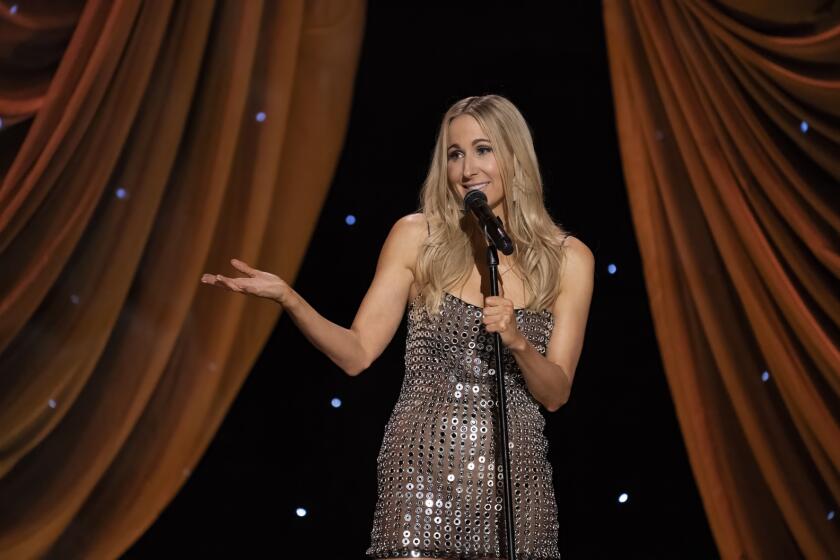‘20th Century Women’s’ 1979 costumes had to straddle two distinct eras
- Share via
Costume designer Jennifer Johnson’s 17-year collaboration with director Mike Mills is showcased in the heartwarming “20th Century Women,” an ode to Mills’ mother, and one that perfectly hits late 1970s ennui as the sexes and the country move into Ronald Reagan’s overdrive 1980s.
The ensemble cast stars Annette Bening as Dorothea Fields, a single mom trying to raise her son, Jamie (newcomer Lucas Jade Zumann), in 1979 Santa Barbara. His coming-of-age is also tended to by a free-spirited, punk-loving photographer, Abbie (Greta Gerwig), his precocious friend, Julie (Elle Fanning), and William (Billy Crudup), a sensitive post-hippie handyman.
“It was a time that was between times,” says Johnson, “and while these periods might look easy [to costume], they often aren’t. You need to take care that trends don’t look too fashion-backward or -forward. But they’re always fun to do because they create a lot of choice.”
That was a transitional year in culture and fashion — how did that play into your costume design?
At first I thought about the more cartoon-y, mid-’70s elements, which this year wasn’t. 1979 was the end of the era moving into another totally different era, and these are often so tough to grasp. You need to pull back a bit. A lot of fashion things in ‘79 would read ’83 or ’84 to the viewer: triangles, bright colors, punkish things going on. You don’t want people to read it, ‘No, wait, that’s not the ‘70s.’”
How did you approach things, then?
No matter what era it is, I like the character to come first. My work needs to be seamless with the script; it doesn’t walk out in front of people. That’s really important to me; a sort of naturalism and authenticity, especially with something like the ’70s since it’s kind of easy to make fun of, you don’t want it to look like a Sears catalog, even though they’re always great references.
For the costume fittings I understand you blended music and fashion together; can you tell us about that?
I brought a record player to the fittings with a stack of records appropriate to that character and invited the actor to pick out their favorite song; so the process of getting to the costume might be circuitous. The actors might not always go straight to the rack. It might be a very long conversation, looking through images, listening to music, talking about politics and forming the costumes not in an obvious straight line.
Abbie had the brightest color palette; how do you decide things like that?
To me the color palettes so often define the characters. For Abbie she’d lived in New York City and we took references from music, culture and art in that punk period. It was a political statement then to have red or pink hair. Now it’s more to be seen, à la Instagram, but then it was a really big deal. It was much like being a hippy.
Annette’s character was a bit rumpled, nothing too precious and ironed; it’s really how I remember the time. So different from the East Coast where you didn’t rumple and schlep.
And with Annette, her hair and makeup and wardrobe are all interesting because they’re so true. Dorothea comes out of the Depression and from a time when women were very coiffed and made-up with slips and heels — and she’s rejected that: She wears Birkenstocks and Wallabies. She was heavily influenced by Mike’s real mom, and after I met Annette and got to know her take on Dorothea, we changed a bit; Dorothea in the film really is a creation of Annette, Mike and myself.
For Lucas’ Jamie Fields, how did his look arrive?
He was so fun to work with because he was totally transformed. The first time he walked into the fitting he wore all pink; pink maharishi pants, pink drop Orbit yogi pants, pink T-shirt with an ohm symbol, a beanie and Toms shoes. A neo-hippie vibe. So it was really fun to strip all that away because it couldn’t be more opposite to what he became in the film. And this was his first film too, and he was next to Annette, who is a wonderful guiding source of light and inspiration for all of us, a perfect person to be next to if you are just starting out. And that was fun to watch.
William’s look is so simple, at first you might think, what is the costume, right?
After the hippies and before the yuppies there was this kind of sexy, sensitive and a bit lonely misfit male — I think many people recognize him — and so Billy needed to feel easy and sexy. It was a very simple look in the late ’70s; the jean with the perfect belt and T-shirt and all of this has now been co-opted by J. Crew and Urban Outfitters. The rough ’n’ tumble denim man. It’s so simple, but it’s the hardest thing to get right because people kept and wore those clothes till they were shredded. They’re very tough to find.
See the most read stories this hour »
More to Read
From the Oscars to the Emmys.
Get the Envelope newsletter for exclusive awards season coverage, behind-the-scenes stories from the Envelope podcast and columnist Glenn Whipp’s must-read analysis.
You may occasionally receive promotional content from the Los Angeles Times.










